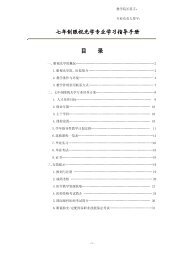Refractive Lens Surgery
Refractive Lens Surgery
Refractive Lens Surgery
You also want an ePaper? Increase the reach of your titles
YUMPU automatically turns print PDFs into web optimized ePapers that Google loves.
26 J.T. Holladay<br />
from morning to night as well as long-term<br />
changes over the past few years. Each of these<br />
factors must be used in determining the desired<br />
postoperative target refraction and to<br />
prepare the patient for the visual changes and<br />
realistic expectations following the procedure.<br />
In all of these cases, biomicrosopy, retinoscopy,<br />
corneal topography and endothelial<br />
cell counts are recommended. These first<br />
three tests are primarily directed at evaluating<br />
the amount of irregular astigmatism. This<br />
determination is extremely important preoperatively<br />
because the irregular astigmatism<br />
may be contributing to the reduced vision<br />
as well as the cataract. The irregular<br />
astigmatism may also be the limiting factor<br />
in the patient’s vision following cataract surgery.<br />
The endothelial cell count is necessary<br />
to recognize any patients with low cell counts<br />
from the previous surgery who may be at<br />
higher risk for corneal decompensation or<br />
prolonged visual recovery.<br />
The potential acuity meter (PAM), super<br />
pinhole and hard contact lens trial are often<br />
helpful as secondary tests in determining the<br />
respective contribution to reduced vision by<br />
the cataract and the corneal irregular astigmatism.<br />
The patient should also be informed<br />
that only the glare from the cataract will be<br />
eliminated; any glare from the keratorefractive<br />
procedure will essentially remain unchanged.<br />
4.3.2.2 Methods of Determining<br />
Corneal Power<br />
Accurately determining the central corneal<br />
refractive power is the most important and<br />
difficult part of the entire intraocular lens<br />
calculation process. The explanation is quite<br />
simple. Our current instruments for measuring<br />
corneal power make too many incorrect<br />
assumptions with corneas that have irregular<br />
astigmatism. The cornea can no longer be<br />
compared to a sphere centrally, the posterior<br />
radius of the cornea is no longer 1.2 mm<br />
steeper than the anterior corneal radius, etc.<br />
Because of these limitations, the calculated<br />
method and the trial hard contact lens<br />
method are most accurate, followed by<br />
corneal topography, automated keratometry<br />
and finally manual keratometry.<br />
4.3.2.2.1 Calculation Method<br />
For the calculation method, three parameters<br />
must be known: the K-readings and refraction<br />
before the keratorefractive procedure<br />
and the stabilized refraction after the keratorefractive<br />
procedure. It is important that the<br />
stabilized postoperative refraction be measured<br />
before any myopic shifts from nuclear<br />
sclerotic cataracts occur. It is also possible for<br />
posterior subcapsular cataracts to cause an<br />
apparent myopic shift, similar to capsular<br />
opacification, where the patient wants more<br />
minus in the refraction to make the letters appear<br />
smaller and darker. The concept that we<br />
described in 1989 subtracts the change in refraction<br />
due to the keratorefractive procedure<br />
at the corneal plane from the original<br />
K-readings before the procedure to arrive at a<br />
calculated postoperative K-reading [19]. This<br />
method is usually the most accurate because<br />
the preoperative K-readings and refraction<br />
are usually accurate to ±0.25 D. An example<br />
calculation to illustrate the calculation<br />
method is given.<br />
Example:<br />
∑ Mean preoperative K = 42.50 @ 90∞<br />
and 41.50 @ 180∞ = 42.00 D<br />
∑ Preoperative refraction =<br />
–10.00 + 1.00 ¥ 90∞,Vertex = 14 mm<br />
∑ Postoperative refraction =<br />
–0.25 + 1.00 ¥ 90∞,Vertex = 14 mm<br />
Step 1. Calculate the spheroequivalent refraction<br />
for refractions at the corneal plane<br />
(SEQ C ) from the spheroequivalent refractions<br />
at the spectacle plane (SEQ S ) at a given<br />
vertex, where



